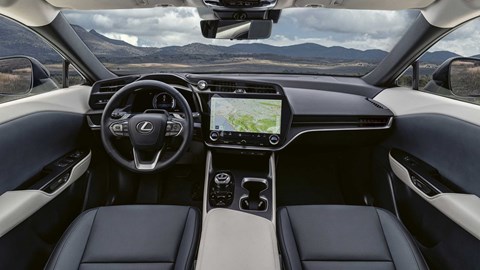► Uses same e-TNGA platform as Toyota bZ4X
► More premium styling, better handling
► One Motion Grip yoke coming in 2023
Lexus has revealed its second all-electric car; the RZ450e. Unlike the UX300e which uses the GA-C platform, the RZ is the first ground-up EV from the brand, and uses Toyota’s brand new e-TNGA platform. The first Lexus EV, the UX300e, used the GA-C platform which was adapted for EV powertrains. The RZ is more closely related to the recently revealed – and more off-road-centric – Toyota bZ4X.

How big is it?
The Hyundai Ioniq 5 is proof the size of electric SUVs can be deceiving, so we’ll get it out the way now: the RZ450e uses a relatively long 2850mm wheelbase, which puts it in the same ballpark as the Audi Q4 e-Tron it’ll soon compete against. For reference, that’s an identical length to its Toyota e-TNGA twin – and both cars share the same minimal overhangs, too.
The shared platform means the Lexus has broadly the same volumes in the same areas as the Toyota, although it’s slightly longer (4805mm to 4690mm) and higher (1635mm to 1650mm). Still, spindle grille onwards, the styling has a far more premium performance-orientated look: Lexus is calling it ‘seamless E-motion’ though we’d settle for swoopy. The biggest difference in styling comes at the rear, where the Lexus features a stealthy C-pillar and full-length light bar – all the rage in 2022.

Tech specs?
The e-TNGA tech underneath means the RZ has a largely similar spec sheet to the bZ, too: a 71.4kW battery with 96 cells sits low in the chassis and promises 250 miles of range on the WLTP cycle. Max power is a combined 309bhp (201bhp on the front axle and 107bhp at the rear) though the Lexus’ overall driving experience should be sportier than its e-TNGA twin.
Looking forward, Lexus expects the battery to retain 90% of its originally charging capability after a decade of normal use. Max speed is 99mph, 0-62mph is just 5.6 seconds, and Lexus is keen to emphasis the RZ’s on-road manners – particularly for its size and weight.
Lexus Europe boss Spiros Fotinos says: ‘Its role will be to create a basis for the driving signature for our future EV portfolio. As a result, RZ will be positioned to deliver an engaging and rewarding on-road driving experience, establishing a new reference in the segment.’
‘That balance, that true driving pleasure, not just linear acceleration, but in the confidence and control that you feel when you’re taking a corner, that will be different than anything you’ve driven in the past. That’s what we’re more interested in.’
The RZ also features Lexus’ DIRECT4 all-wheel-drive system, though it’s not clear if this is a rebadged version of the Subaru tech in the bZ4X. We’ll update this article when we know more.
Interior
Lexus is slotting in the same infotainment system as the NX, which means Android Auto and Apple CarPlay as well as a ‘Hey Lexus’ assistant. There’s a panoramic and dimmable roof. However, alongside the usual driver-centric ‘Tazuna’ approach, the RZ450e also gets the same steer-by-wire system promised in the Toyota bZ4X.
Similar to Tesla’s solution on the surface, the Lexus/Toyota One Motion Grip system is a little different; for a start it’s 150-degrees from lock-to-lock with a progressive response that should help in high-speed driving, winds and more – but also aid low speed manoeuvres. Lexus and Toyota say it’ll provide a better view of the instruments at all times, too. It’ll arrive in 2023.
The RZ will be one of 20 new or revised Lexus models in Europe by 2025 – a mix of full electric, plug-in hybrid and ‘self charging’ hybrids. The target was to increase Europe-wide sales to 130,000 cars a year, or 50 per cent above the brand’s previous best year, 2019.